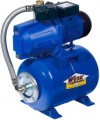Pump housing material
The material from which the pump housing is made. It is a structural element in which the working mechanism (impeller or auger) is installed. Note that the motor casing can be made of a different material — this is not important in this case; and in water pumps with the engine (see “Power source”), we are talking about the casing of the pump itself, and not about the support frame in which it is fixed.
The following options are most popular nowadays:
— Plastic. Inexpensive material that perfectly resists moisture and is not subject to corrosion. However, the reliability of plastic as a whole is not very high; the exception is special high-strength grades, but they are extremely rare in pumps (when strength is needed, metals are usually used). So plastic housing is mainly equipped with relatively simple and affordable models that are not designed for serious loads.
— Cast iron. An extremely popular material nowadays: cast iron is strong, reliable, durable and at the same time has a relatively low cost. However, in terms of corrosion resistance, this material is inferior to stainless steel (see below). Nevertheless, subject to the rules for operating the pump, the service life of the cast-iron housing is not inferior to the service life of most of the main components of the unit. Also note that such cases are quite massive, which makes transportation difficult; however, in some cases, a large weight is an advantage: it helps to dampen vibrati...ons.
— Stainless steel. By the name, one of the key advantages of stainless steel is high resistance to corrosion — and, accordingly, reliability and durability. On the other hand, this material also costs a little more than the same cast iron. The weight of such housing is somewhat less — this, again, can be both an advantage and a disadvantage, depending on the situation.
— Aluminium. Premium material. The aluminium alloys used in today's pumps are light, strong, durable, and virtually impervious to moisture, but cost accordingly.
— Brass. A fairly rare option found in some models of surface pumps. Brass is strong enough, reliable and resistant to moisture, but in most cases, it does not have key advantages over the same stainless steel or aluminium but costs a little more.
— Bronze. Another material similar to the brass described above is durable and practical but rarely used.
— Ceramics. A material found exclusively in sewage pumps in the form of toilet bowls (see "Pump design"). Most often, ceramics means vitreous china or more expensive and durable vitreous china — that is, the same materials as in ordinary toilets without built-in pumps.
Water pressure tank material
The material of the water pressure tank provided in the design of the pumping station.
Recall that the classic (not sewer) pumping station is a surface pump, supplemented by a water pressure tank. Such a tank is a reservoir where water accumulates. It performs two functions: it smooths out pressure drops in the system and stores some water in case the pump is turned off. For the main body in such containers, the following materials can be used:
— Cast iron. The simplest and most inexpensive option: cast iron is somewhat inferior to stainless steel in terms of strength and corrosion resistance. However, for those models in which it is used, these moments do not have a noticeable meaning.
— Stainless steel. The most advanced material in use: stainless steel combines high strength and corrosion resistance. However, such tanks are somewhat more expensive than other varieties.
— Steel. Non-stainless steel accumulators usually use special coatings to protect against corrosion. This material is superior to cast iron in strength and is somewhat cheaper than stainless steel.
— Aluminium. The main advantage of aluminium alloys is their light weight combined with quite decent strength and rust resistance. Of the shortcomings, a rather high price can be noted.

